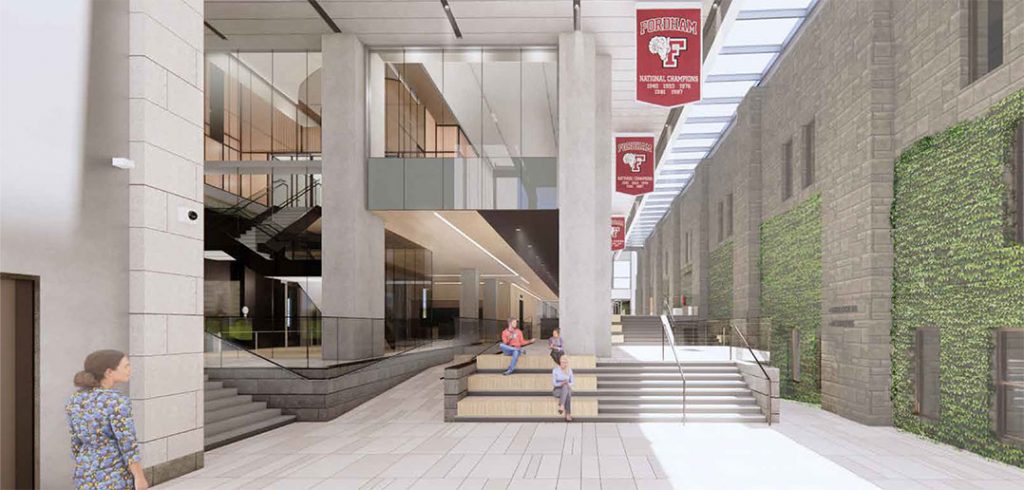On March 16, Fordham received a helping hand from the State of New York, which awarded the University a $5 million matching capital grant from the Higher Education Capital Match Program (HECap).
The grant, which is administered by the Dormitory Authority of the State of New York (DASNY), will pay for construction of the glass-covered arcade, or passageway, that will connect the new 71,000-square-foot, four-level addition to a renovated McGinley Center, the Rose Hill Gym, and the Lombardi Center. The addition is set to open this fall.
A Partnership with State Government
For every dollar in state matching funds, private, not-for-profit colleges and universities in New York must provide $3 in support of their projects. The projected timeline of the campus center’s Phase II renovation is expected to be 14 months.
Fordham was one of 35 colleges and universities to receive the grant this year. Lesley Massiah-Arthur, associate vice president and special assistant to the president for government relations, whose office secured the grant, said she was thrilled that Fordham received the maximum amount possible. A major part of the application process centered around demonstrating that the project will generate jobs and benefit the community at large, she said.
“What this investment allows us to do is not only expand the University’s resources for our students but to expand community access to the University,” she said, noting that Fordham allows community nonprofits to hold meetings on campus, free of charge.
Contributing to the Economy
At $5 million, the grant is the largest in a series of grants totaling $14.75 million that Fordham has secured from the state over the last five years. Last year, a $2.5 million State and Municipal Facilities Grant was awarded for lab renovations at John Mulcahy Hall. In 2018, the University received a $3.75 million HECap grant for a steam boiler replacement in Thebaud Hall. And in 2019, Massiah-Arthur’s office secured a $1 million HECap grant for renovating the façade and creating an open green space at Lincoln Center.
Massiah-Arthur said the funds showed that leaders in Albany appreciate the value that private colleges and universities bring to the state’s economy. According to a 2017 report by the Commission on Independent Colleges and Universities, Fordham’s total economic impact on the New York City region is $1.5 billion.
The project will also generate approximately 250 union jobs, ranging from laborers to engineers, over the course of the contract.
“The fact that independent universities have a capital program [HECap] that’s specific to us demonstrates that our capital construction is very important, especially when you consider that as a sector, our institutions contribute about $88 billion to the New York state economy,” she said.
“This just goes to show that a partnership between the state and our sector can be a benefit not just for the institution but the state, the regions, and communities we’re in.”
Joseph M. McShane, S.J., president of Fordham, who recently served as chair of the Commission on Independent Colleges and Universities, said he was gratified that New York’s leaders see institutions like Fordham as partners worthy of support.
“The new center will be at the heart of the campus experience and therefore at the heart of the University’s mission,” Father McShane said.
“It will bring together all students, faculty, and staff under one roof, in a space that maximizes opportunities for shared meals, shared learning, and shared recreation. We are grateful that the Dormitory Authority recognized both Fordham’s need and our contribution to the state’s intellectual, cultural, and financial health.”
A Unique, Light-Filled Space
The arcade and the new entrance to the center promise to be the most dramatic of all the elements of the new campus center. Marco Valera, vice president for administration, said that the only other building that currently features a large indoor space bathed in natural light from above is the Platt Court atrium at the Lincoln Center Campus.
In addition to joining the original McGinley Center with the addition, the new arcade will stretch to the east and north to envelop the space separating those two buildings from the Rose Hill Gym and the Lombardi Center.
It is also arguably the trickiest part of the construction, Valera said, as it requires demolition, rehabilitation, and construction in close proximity to spaces that will continue to be occupied.
“The uniqueness of this particular space is that it joins the new building with the old stonework of the gym, so you’ve got a little flavor of the kind of gallery at the Metropolitan Museum of Art where they join old buildings to new buildings,” he said.


